On the Probationer Reception
“Oh no! Another article about it!” — you may be thinking, and I don’t blame you. One of the most discussed steps on the A∴A∴ is the Probationer Grade. It’s the first actual grade, and most A∴A∴ enthusiasts either already went through it or are applying to it. However, going through the A∴A∴ archives and the many changes that occurred through the years, there are many particularities that you may not be familiar with, so I invite you to stick around and read some curiousities about this Grade.
Early Applications #
The A∴A∴ started to take shape around 1906, when Aleister Crowley (Frater Perdurabo) and George Cecil Jones (Frater D.D.S.) – his friend and occult mentor – discussed the creation of a new occult order to replace the Hermetic Order of the Golden Dawn, fixing what they considered to be issues in the old system and expanding its Path to include Eastern traditions.
“Sunday night. D.D.S. and P. discuss a new O«rder». D.D.S. wants Authority. I should write and say ‘Perfect the lightning-conductor and the flash wil come.’ (Crowley’s diary, Jul. 29, 1906)
“Very true; but there need not be hesitation any more.” (note appended on Dec. 31)
Although on 1907 Crowley and Jones were in contact with a few potential members for the A∴A∴ – including Captain J. F. C. Fuller (who would become the third officer in Its leadership) and Victor Neuburg (who would be a part of important Workings and Revelations later) – they only started to actively announce the A∴A∴ and recruit members in 1909.
To join the A∴A∴, the early applicants from 1909 had to sign the same document that is used today, which contains the “Oath of a Probationer” and the “Tasks of a Probationer”. In that document, the admission process is summarized as follows:
“Let any person be received by a Neophyte, the latter being responsible to his Zelator. […] The aspirant to the A∴A∴ shall hear the Lection (Liber LXI) and this note of his office; IF HE WILL, shall then procure the robe of a Probationer; shall choose with deep forethought and intense solemnity a motto. On reception, he shall receive the robe, sign the form provided and repeat the oath appointed, and receive the First Volume of the Book.”
Let’s dive a little beep deeper into these proceedings, expanding what each element means, some contradictory instructions and how the process evolved.
Who’s welcome in the A∴A∴? #
Any person can request admission to the Order, however, due to the sensitive contents of the materials studied in the A∴A∴, the doorkeeper may only admit adults.
A small list of formal requirements was set forth two decades later (1929) in One Star in Sight:
“[…] all Members of the A∴A∴ […] must accept the Book of the Law as the Word and the Letter of Truth, and the sole Rule of Life.
They must acknowledge the Authority of the Beast 666 and of the Scarlet Woman as in the book it is defined, and accept Their Will as concentrating the Will of our Whole Order.
They must accept the Crowned and Conquering Child as the Lord of the Aeon, and exert themselves to establish His reign upon Earth.
They must acknowledge that ‘The word of the Law is Θελημα’ and that ‘Love is the law, love under will.’ Each member must make it his main work to discover for himself his own true will, and to do it, and do nothing else.
He must accept those orders in the Book of the Law that apply to himself as being necessarily in accordance with his own true will, and execute the same to the letter with all the energy, courage, and ability that he can command.”
Some of these statements are very esoteric and may not make any sense to the candidate (if you are new into this, relax — nothing “evil” or “diabolic” is implied here). Even after 1929, it is possible that the applicant wouldn’t know about these requirements unless he stumbled upon the essay One Star in Sight in the Appendices of Magick in Theory and Practice.
Since originally The Book of the Law was a secret document only available to members of the Zelator 2○=9□ Grade, probably these requirements were never applied for the earliest member back in 1909.
Admission paperwork #
A few documents are mentioned in the admission procedure summary, but it may not be clear what exactly they are, especially for newcomers:
“The aspirant to the A∴A∴ shall hear the Lection (Liber LXI)”
Liber LXI is Liber LXI vel Causæ (“The Preliminary Lection, including the History Lection”), which summarizes the rise and fall of the Hermetic Order of the Golden Dawn, and the creation of the A∴A∴ by Frater P. and D.D.S. Again, some of its history lection won’t ring a bell to someone who’s not familiar with the G.D. The candidate may need to ask for the Neophyte to clarify this account.
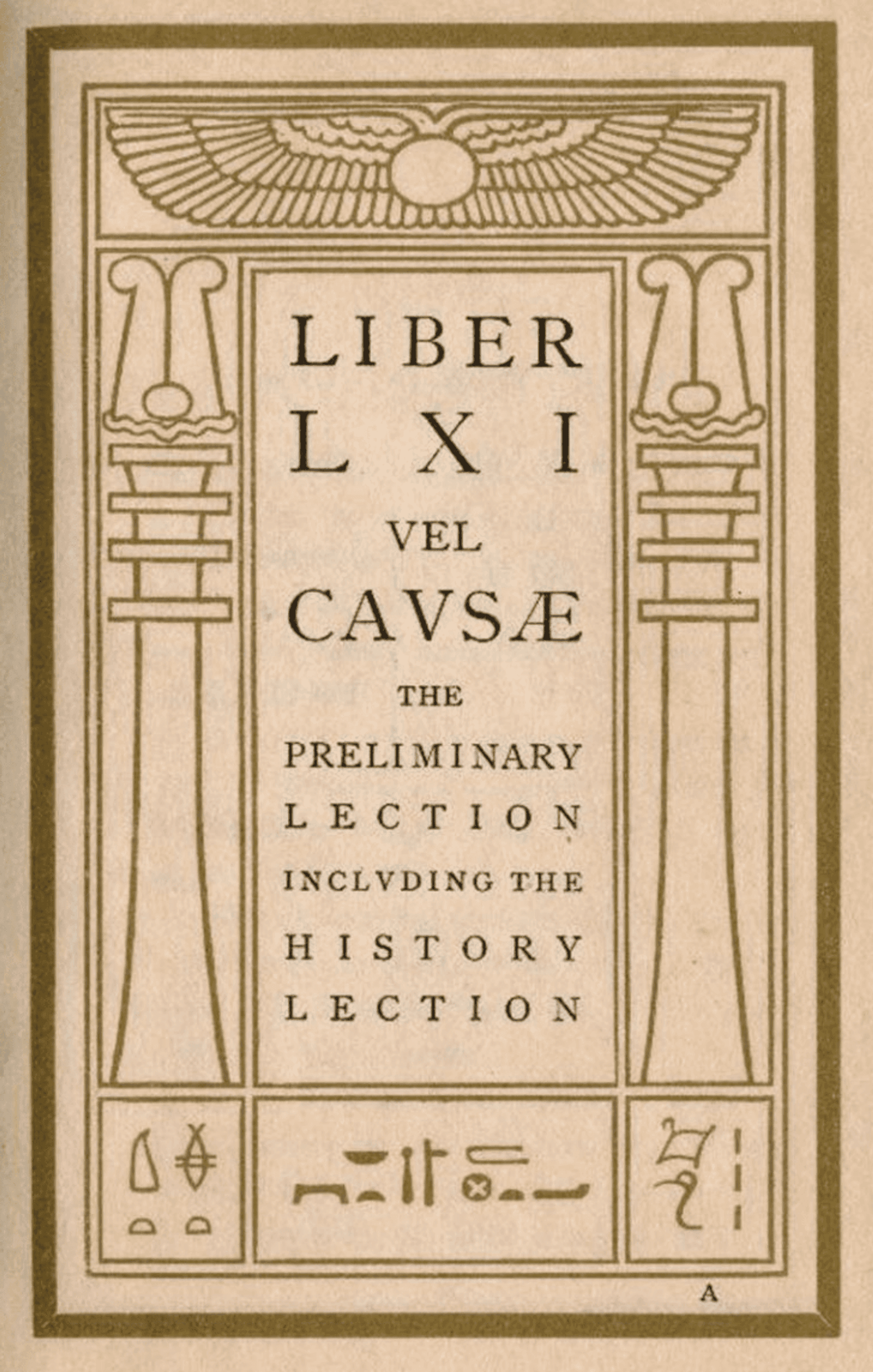
“The aspirant to the A∴A∴ shall hear the Lection […] and this note of his office; […]. On reception, he shall […] sign the form provided […].”
The “note of his office” is, of course, the “Task of a Probationer” itself. The “form provided” is “The Oath of a Probationer” figuring in the opposite side of the page. Here are some photos of the old original forms:
| Oath (front): | Task (back): |
|---|---|
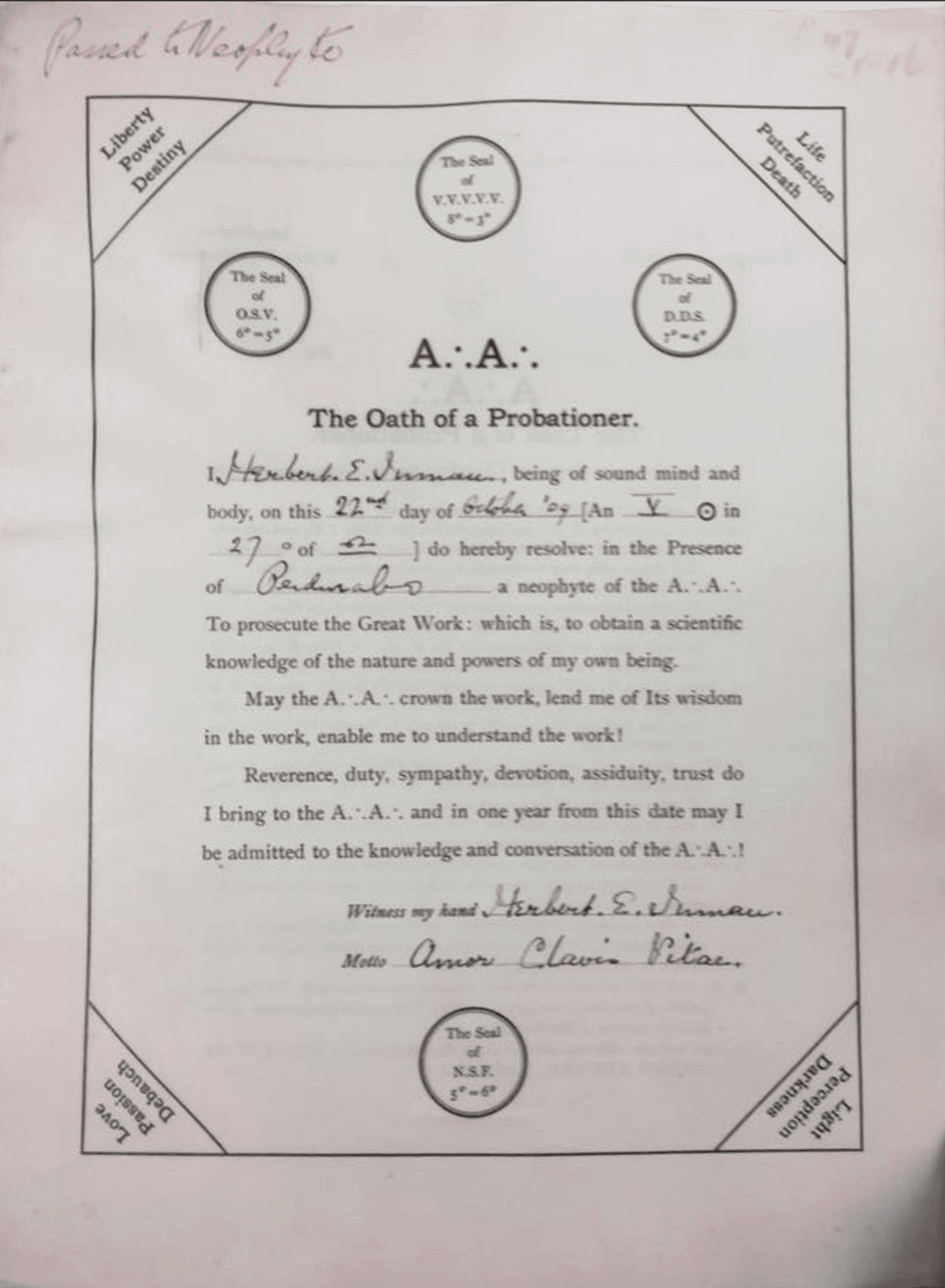 | 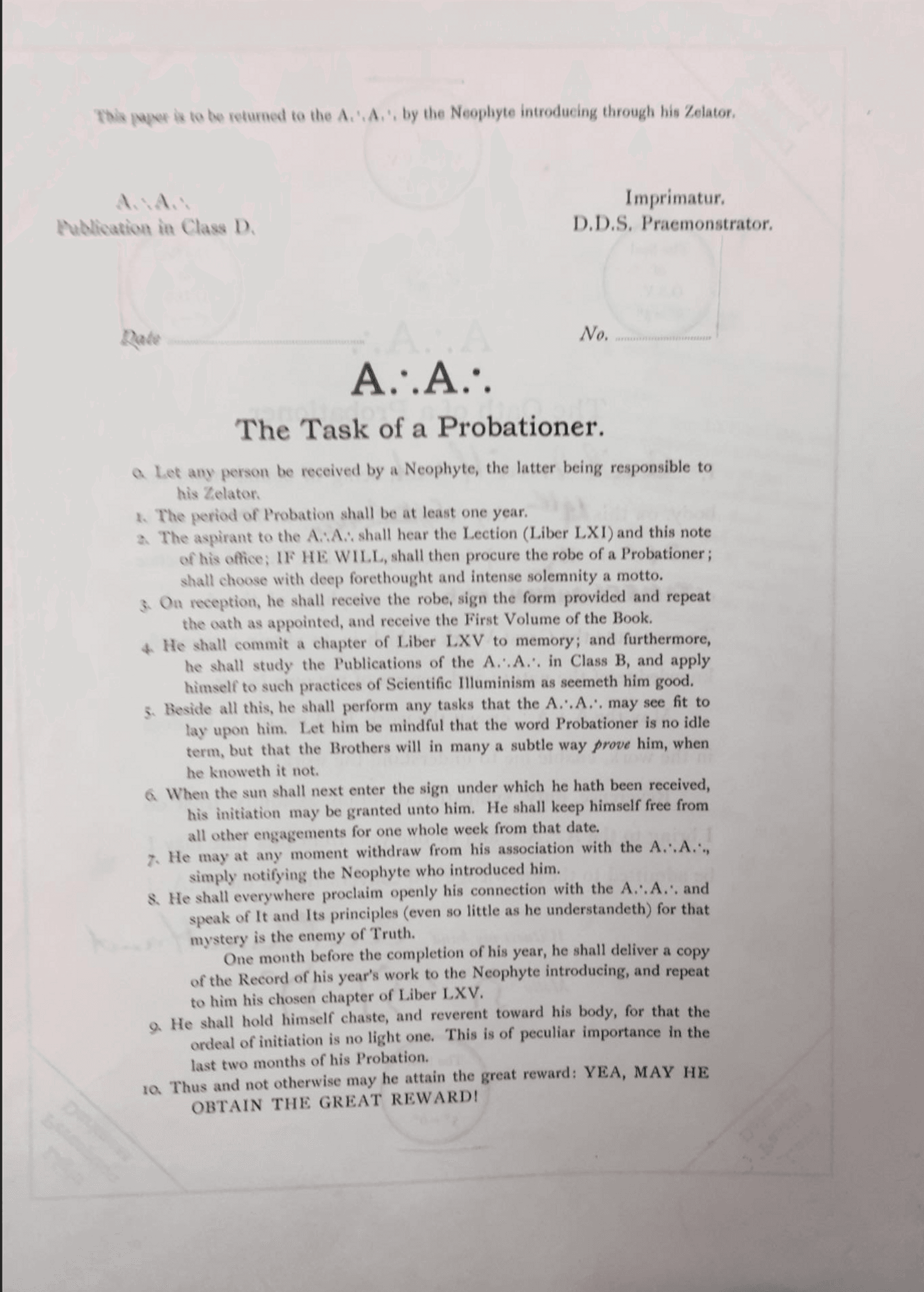 |
“On reception, he shall […] receive the First Volume of the Book.”
“The Book” refers to a book simply called “ΘΕΛΗΜΑ”, containing part of the Holy Books of Thelema splitten accross 3 volumes according to the table below. Each volume is delivered at a certain point in the progress of the Grades.
| Volume | Contents | Delivered to | Intended for |
|---|---|---|---|
| 1 | Liber LXI vel Causæ Liber Cordis Cincti Serpente | Probationer 0○=0□ | Probationer 0○=0□ |
| 2 | Liber Liberi vel Lapidis Lazuli | Neophyte 1○=10□ | Neophyte 1○=10□ |
| 3 | Liber AL vel Legis Liber Trigrammaton Liber DCCCXIII vel ARARITA | Zelator 2○=9□ | Zelator 2○=9□ Practicus 3○=8□ Philosophus 4○=7□ |
(The cover of “The Book”):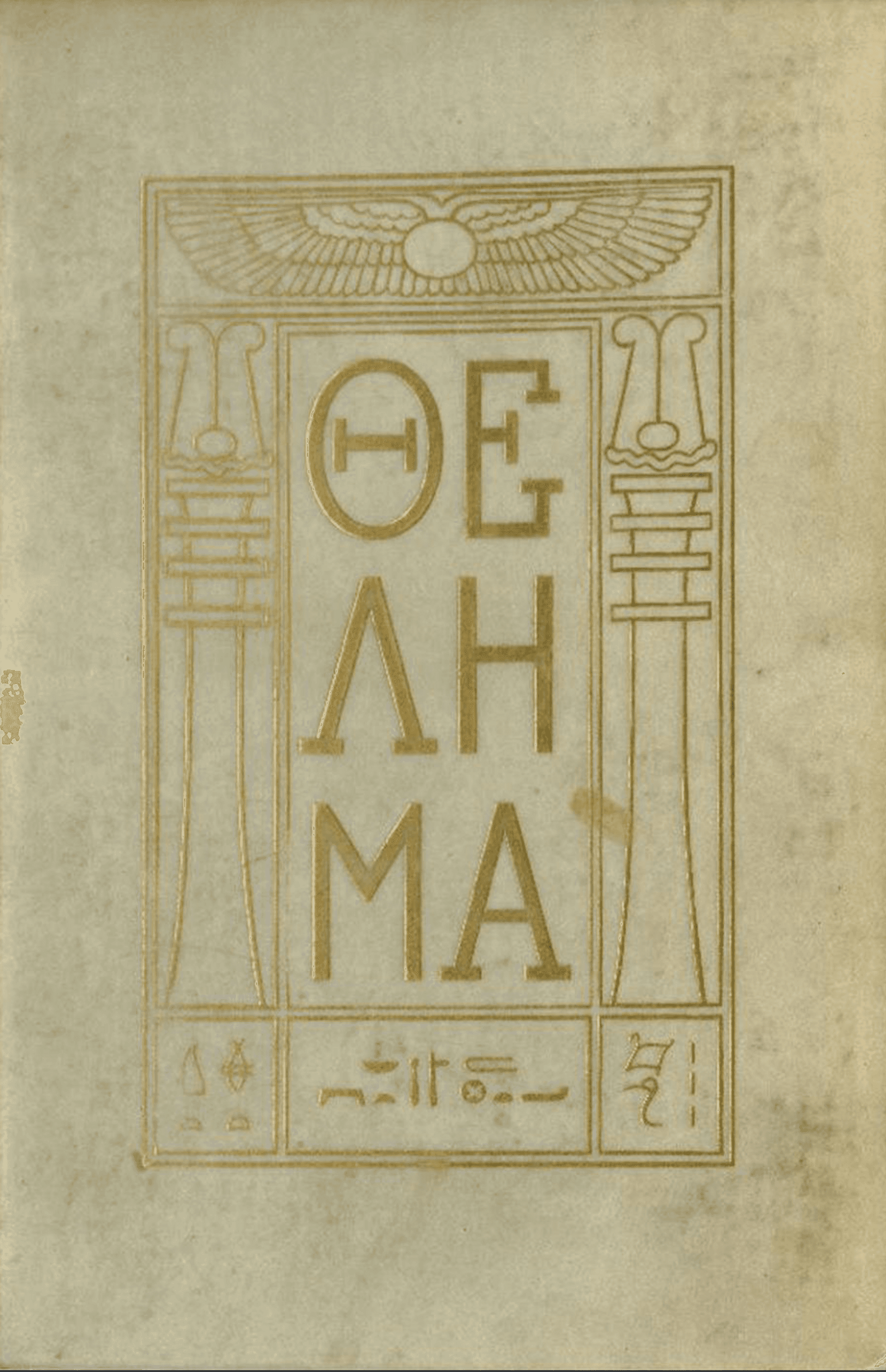
Are there any fees? #
In the early days, according to the “Tasks of a Neophyte”, i.e., the next Grade after Probationer, you would pay:
“One Guinea for Liber VII which will be given him on his initiation, and One Guinea for this Portfolio of Class D publications, B-G” (Task of a Neophyte, Liber Collegii Sancti).
Liber VII is included in the second volume of ΘΕΛΗΜΑ, as explained above. The portfolio of publications B-G is Liber Collegii Sancti: a folder containing the Oaths and Tasks of the Outer College of the A∴A∴. The member would use these papers to check his progress through the current and later Grades. He would prepend to it paper A, which is the Oath and Task of a Probationer – a document he already had.
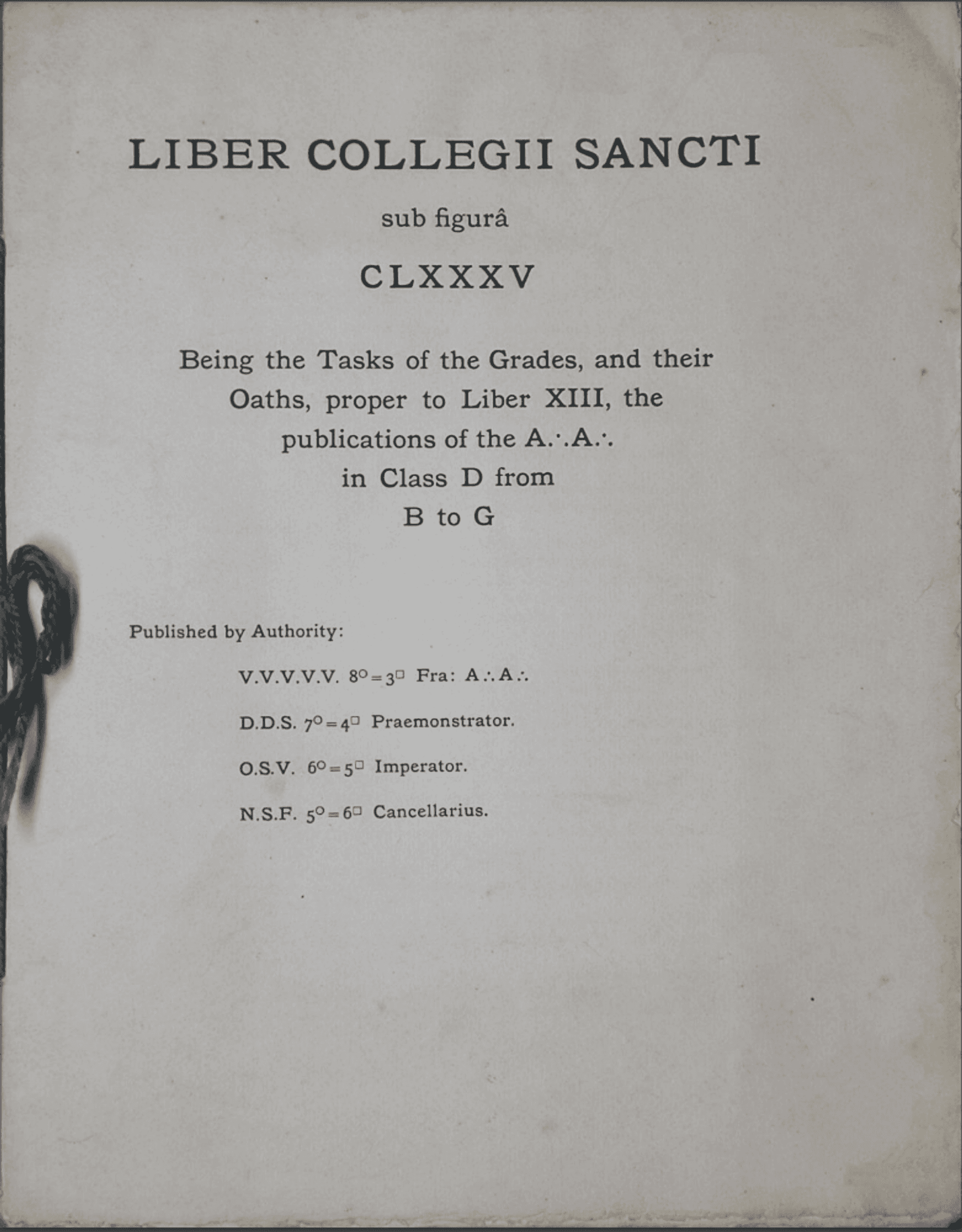
Later, as a Zelator, he would pay “the sum of Three Guineas for the volume containing Liber CCXX, Liber XXVII and Liber DCCCXIII”, i.e., the third volume of ΘΕΛΗΜΑ.
There’s no mention of any fees for the Probationer in his Tasks, but are there any hidden fees? Let’s read what is written in the notes included in the 1910 edition of Liber Causæ:
“The cost of the [First Volume of the] Book is One Guinea, and must be paid at the time of reception to the Neophyte admitting.”
Also, the First Volume of the Book states:
“The Price, one Guinea, is to be remitted to the Treasurer through the Neophyte introducing.” (ΘΕΛΗΜΑ, Vol. I, 1909).
Crowley wrote in a letter to W. F. Nott, around 1913:
“No expense is entailed on probation, except the cost of the necessary book mentioned, £1-1s-0. The A∴A∴ does not make money in any shape or form. All their books are sold at a cost which represents out of pocket expenses for printing, and those who serve them give their work without reward of any kind.”
Here “£1-1s-0” means one pound and one shilling, the same amount as one guinea. According to Mandy Barrow, 1 guinea was equivalent to £1.05 in modern currency. Cheap, right? But if we consider the inflation rates since 1909 using Ian Webster’s calculator, that amount is equivalent to around £159.90 (or USD 198.46) in early 2023. I am not considering here the average purchase power of the people at the time, but just as a comparison, with that money you could buy around 60 pints of Guinness beer on 1910 or around 3 copies of Bram Stoker’s Dracula on 1897.
The three volumes were luxurious books printed in small quantities, so this — and the fact that the A∴A∴ had an office and later a telephone number — maybe explains a bit of the high price. Not everybody would be able to afford them, but eventually most of them were publicly printed as part of The Equinox, at a better price.
Today people don’t have to worry about it, because we can find all these instructions easily on the Internet or in affordable books. As far as I know, no A∴A∴ claimant group is demanding those fees.
You only get one shot #
Some people understand, based on (Liber Causæ), that a given person can only request admission to the Order once in their lifetime:
“Listen, we pray you, with attention: for once only does the Great Order knock at any one door. Whosoever knows any member of that Order as such, can never know another, until he too has attained to mastery. Here, therefore, we pause, that you may thoroughly search yourself, and consider if you are yet fitted to take an irrevocable step. For the reading of that which follows is Recorded.” (Liber Causæ)
These notes found in the second edition of Liber LXI corroborate with the idea:
“This copy is lent to the correspondent on the distinct understanding that he will return it within Two hours of its receipt, with a definite answer Yes or No as to wether he will proceed to take the obligation of a Probationer.” (Liber Causæ, 1910 edition)
A special authorization issued by the Cancellarius (which will be discussed later) also confirms the restriction, and makes it clear that the reading of Liber LXI indeed is recorded:
“The name of any Aspirant to whom the Lections have been read must in any case be forwarded […] as no man is permitted to apply a second time. The Aspirant must decide definitely at the time of reading whether or no he will proceed.”
In-person reception #
The Probationer is received in person by a Neophyte, i.e., someone at least from the Grade immediately above his, who would be acting on behalf of his Zelator (i.e., the supervisor of his supervisor), following the chain of instructor-student refering back to the founding members[1]:
“It is simple to write to the Chancellor of the A∴A∴ […]; a neophyte of the Order will be detailed to meet the inquirer. He will read to him the History of the Order and explain the task of the Probationer.” (The Equinox I(2), Sep. 1909)
The physical presence of someone from the A∴A∴ supervising the admission of the Probationer is very important, but as you may guess, in the beginning there was more people applying to join than available supervisors to receive them.
George Cecil Jones never admitted anyone in the A∴A∴, although he previously acted as Crowley’s mentor in the Golden Dawn. So, in 1909, there was only one person in the Neophyte grade (or above) to admit new Probationers: Crowley himself. In 1910, 3 people made it to Neophyte. In 1911, there was Crowley + 4 more active members able to admit new members, and 41 enlisted Probationers.
Since receiving people in person was something very important, and sometimes a Neophyte wouldn’t be close enough or even available to admit new members, the A∴A∴ issued a special dispensation allowing Probationers to receive other Probationers:
“The Probationer … is hereby authorized to act as a Neophyte for the purpose of enrolling other Probationers: i.e. to explain the tenets of Skeptical Theurgy or Scientific Illuminism; to read the Preliminary and History Lections; and to receive the Aspirant. […] This permission will be valid for one year, and may then be renewed at my discretion. But it should be remember that only exceptional circumstances justify the Probationer in failing to take up his Initiation at the end of his year.”
(This exception of allowing Probationers to enroll other Probationers was only kept when there was no enough people in the Neophyte Grade and above. It does not seem to be the case nowadays.)
Today, there are A∴A∴ claimant groups which do not require the candidates to be physically present in front of the Neophyte to be admitted as Probationers, while others keep the tradition of the in-person reception. Personally, I think it is pretty cool the idea that you are in front of your superior in the same way as all of your predecessors were in front of theirs – even if your claimant group does not require you to be “in presence of” your superior for the admission and/or advancements, you should consider traveling and meeting yours.
Should I acquire a Magical Robe? #
To each grade of the A∴A∴ is attributed a specific design of a “magical robe”[2], the counterpart of the Golden Dawn sashes and the Freemasonry aprons.
“The robe of a Probationer should be obtained from Mr. W. Northam, 9, Henrietta Street, Covent Garden, London, who charges Five Pounds for it.” (Liber Causæ, 1910 edition)
How much was Five Pounds? Applying the same formulas as before, it would be equivalent to £5 in modern currency, which, updated with inflactions rates, would be equivalent to £761.45 (or USD 952.12) in 2023. Fortunately, nowadays you can find photos and diagrams[2:1] so you can hire the local “robemaker” to make one for you or buy one from Aly Moon Magick Crafts at a much lower cost.
The Probationer robe is a central part of the admission process. There is a strong emphasis on the importance of the Neophyte actually delivering the robe in the hands of the Probationer:
“The admission is not valid unless the Neophyte hand the robe to the Probationer with his own hands; or in the case of correspondence through the post — a method which is not to be employed without grave reason — write formally ‘I bestow the robe upon you’.” (Liber Causæ, 1910 edition)
However, we find two contradictions here:
- It opens the possibility of reception via “correspondence through the post”, contradicting the requirement of an in-person reception.
- The “Task of a Probationer” states that “IF HE WILL, shall then procure the robe of a Probationer”, suggesting that the Probationer robe is optional, contradicting the above requirement.
Even if your A∴A∴ claimant group does not require the robe, you should consider obtaining one. As Crowley says in a letter to a prospective A∴A∴ candidate:
“The only other thing is that you keep the Robe for doing your meditation. It is found useful, for a great many people, to make a complete distinction betwen the ordinary life and the work. You put on the robe when going to meditate very much as you dress for dinner.” (Crowley to Mrs. Grahan, 1913)
The instruction for the advancement to the next Grade (Neophyte) is clear regarding the requirement of the magical robe: “Let [the Probatiober] obtain the robe of a Neophyte, and entrust the same to the care of his Neophyte”. It is not optional.
The Student of the Mysteries #
Three years after publicly announcing the A∴A∴, Crowley decided to change the Probationer admission procedure by adding a new preliminary step called Student of the Mysteries:
“Owing to the unnecessary strain thrown upon Neophytes by unprepared persons totally ignorant of the groundwork taking the Oath of a Probationer, the Imperator of A∴A∴, under the seal and by the authority of V.V.V.V.V., ordains that every person wishing to become a Probationer of A∴A∴ must first pass three months as a Student of the Mysteries.
He must possess the following books: — […]
An examination in these books will be made. The Student is expected to show a thorough acquaintance with them, but not necessarily to understand them in any deeper sense. On passing the examination he may be admitted to the grade of Probationer.” (The Equinox Vol I. Nº. 7, mar. 1912)
The list of books changed over time, as Frater Orpheus perfectly explains in his article.
Here is what Crowley had to say about this step to a prospective candidate:
“After 3 months means any time convenient when that period has elapsed. When you think you are ready to be examined, you apply. […] With regard to personal instruction, I am always willing to see pupils by appointment and explain anything which may remain obscure. It is, however, desirable that pupils should study these books as in the course of teaching I have to refer to many statements in those books, and a study of them on your part saves my time.” (Crowley to Nott, 1913)
Frater Orpheus also wrote an excellent article on the Student examination, so there’s not much left to say about it but leave you with a quote of a letter Crowley sent to Windram:
“I am sending you three sets of probationer papers. As a Neophyte, you have full authority to admit anyone you like. Please remember that the Student qualification should not be neglected, but there is no intention of worrying people about it. It’s only object is to prevent persons entirely ignorant of the subjects bothering other people with silly questions which they ought to know. As long as the man knows his way about the Equinox it is quite alright to pass him.” (Crowley to Windram, 1913)
Today, there are A∴A∴ claimant groups which slightly changed some of these procedures. Here are a few examples without names:
- Receiving new candidates as Probationers skipping the Student step;
- Changing the implementation of the Student period by applying different lists of books (specially in countries where English is not the first language) or different examination forms;
- Implementation of a Student Oath;
- Accepting the conclusion of other courses or grades in other Thelemic orders as an alternative fulfillment of the Student period.
Conclusion #
The Probationer reception procedures have undoubtedly evolved over time, even when Crowley was alive. There are different viewpoints among individuals regarding these procedures. Some prefer to adhere strictly to the original methods from the early years, valuing tradition above all else. Others take a progressive approach, seeking to enhance and improve the A∴A∴ system as they view it. A third group maintains the original form while adding to it, refusing to remove any elements. What is your stance on this matter?
Bibliography #
- 100th Monkey Press.
- Keep Silence.
- Aleister Crowley diaries and letters from the A∴A∴ archives.
- Perdurabo, by Richard Kaczynski.
- Magick in Theory and Practice, by Aleister Crowley.
Read more abou the chain of supervisors and students in “What is an A∴A∴ lineage?”. ↩︎
To learn more about the magical robes of the Order, read “The A∴A∴ Robe Design”. ↩︎ ↩︎
Thanks for reading
Since you've made it this far, sharing this article on your favorite social media network would be highly appreciated 💖! For feedback, please write to alanwillms at gmail dot com.